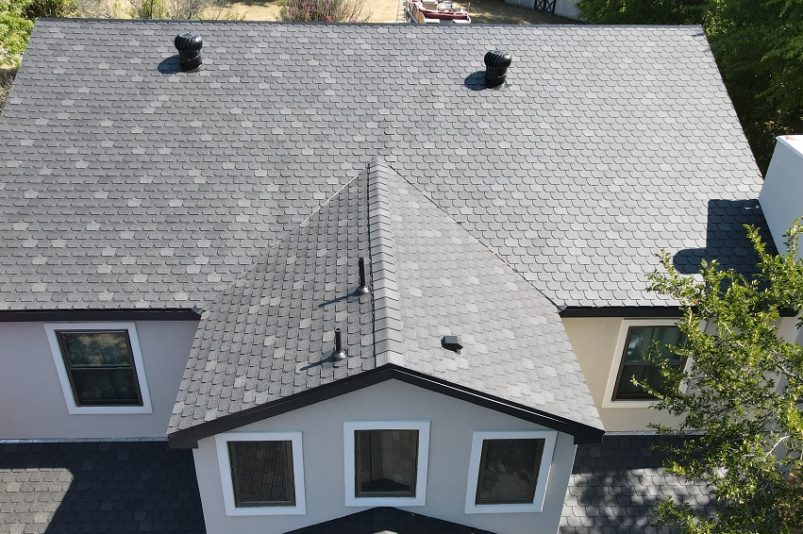
Cap sheet roofing is a popular choice among building owners and contractors for its durability, weather resistance, and cost-effectiveness. This article will provide an in-depth look into cap sheet roofing, its components, benefits, types, installation process, and maintenance.
Components of Cap Sheet Roofing
Cap sheet roofing is a multi-layered system comprised of the following:
Base Sheets
The foundation of cap sheet roofing is the base sheet, typically made of fiberglass or polyester. The base sheet is designed to provide a solid, stable surface for the other layers to adhere to, ensuring a secure and long-lasting bond.
Interply Sheets
Interply sheets, also known as ply sheets, are placed between the base sheet and cap sheet. These layers can vary in number and are typically made of fiberglass or polyester. They add structural strength and help to distribute weight evenly across the roof surface.
Cap Sheets
The top layer of the roofing system is the cap sheet. It consists of a heavy-duty, weather-resistant material, usually modified bitumen, reinforced with fiberglass or polyester. Cap sheets provide the final barrier against the elements, including UV radiation, rain, and wind.
Benefits of Cap Sheet Roofing
Cap sheet roofing offers several advantages over traditional roofing materials:
Durability
The multi-layered structure of cap sheet roofing provides exceptional durability and resistance to wear and tear. It can withstand harsh weather conditions and has a longer lifespan compared to other roofing materials.
Waterproofing
The cap sheet creates an impermeable barrier that prevents water infiltration, making it an excellent choice for regions with heavy rainfall or snow.
Fire-resistant
Cap sheets are often treated with fire-resistant materials, providing an added layer of protection against fire hazards.
Energy Efficiency
Cap sheet roofing reflects solar radiation, reducing heat absorption, and keeping indoor temperatures cooler. This can lead to lower energy bills and improved comfort for building occupants.
Types of Cap Sheet Roofing
There are two main types of cap sheet roofing:
SBS-Modified Bitumen Cap Sheets
SBS (styrene-butadiene-styrene) modified bitumen cap sheets provide flexibility and adaptability to varying temperatures. They are highly resistant to thermal shock and offer excellent weather resistance.
APP-Modified Bitumen Cap Sheets
APP (atactic polypropylene) modified bitumen cap sheets are known for their exceptional heat resistance and ability to withstand extreme temperature fluctuations. They also offer impressive tensile strength and durability.
Cap Sheet Roofing Installation
Installing a cap sheet roofing system requires specific tools and materials, as well as adherence to the proper installation process:
Tools and Materials
Some of the essential tools and materials for cap sheet roofing installation include:
- Roofing nails
- Roofing cement
- Primer
- Modified bitumen sheets (base, interply, and cap sheets)
- Roofing torch or hot-air welder
- Utility knife
- Trowel
- Broom
- Seam roller
Installation Process
The installation process for cap sheet roofing can vary depending on the specific product and manufacturer’s instructions. However, the general steps include:
- Preparing the roof surface: Remove any debris and clean the roof surface thoroughly.
- Priming the surface: Apply a primer to the roof surface, ensuring proper adhesion of the roofing materials.
- Installing the base sheet: Fasten the base sheet to the roof surface using roofing nails or adhesive.
- Installing interply sheets (if applicable): Position the interply sheets over the base sheet, overlapping the edges as specified by the manufacturer. Heat-weld or adhere the interply sheets in place.
- Installing the cap sheet: Align the cap sheet over the interply sheets or base sheet, overlapping the edges as instructed. Heat-weld or adhere the cap sheet in place.
- Sealing the edges: Apply roofing cement to the edges of the cap sheet and press it down with a trowel or seam roller, ensuring a watertight seal.
Maintenance and Repair
Routine maintenance is crucial to ensuring the longevity and performance of a cap sheet roofing system. Regular inspections can help identify potential issues early, preventing extensive damage and costly repairs. If damage is detected, timely repairs should be conducted to maintain the integrity of the roofing system.
Conclusion
Cap sheet roofing is a durable, weather-resistant, and cost-effective solution for various types of buildings. Understanding the components, benefits, types, installation process, and maintenance requirements can help property owners and contractors make informed decisions when selecting the best roofing system for their needs.
FAQ
Q: What is the average lifespan of cap sheet roofing?
A: Cap sheet roofing systems typically have a lifespan of 20-30 years, depending on factors such as installation quality, maintenance, and environmental conditions.
Q: Is cap sheet roofing suitable for all climates?
A: Cap sheet roofing is designed to withstand various climate conditions, including extreme temperature fluctuations, heavy rainfall, and strong winds. However, it’s essential to select the appropriate type of cap sheet (SBS or APP) based on the specific climate.
Q: How much does cap sheet roofing cost?
A: The cost of cap sheet roofing varies depending on factors like material quality, labor costs, and geographic location. It’s essential to obtain quotes from multiple contractors to determine the most cost-effective solution for your project.
Q: Can cap sheet roofing be installed over an existing roof?
A: In some cases, cap sheet roofing can be installed over an existing roof, provided the roof surface is clean, dry, and structurally sound. However, it’s crucial to consult with a professional roofer before proceeding with this option.
Q: Is cap sheet roofing eco-friendly?
A: Cap sheet roofing materials are often recyclable, and the reflective properties of the cap sheet can improve energy efficiency, reducing the building’s carbon footprint. However, the environmental impact depends on factors like material sourcing, manufacturing processes, and disposal methods.





